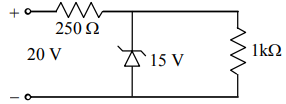The following configuration of the logic gate is equivalent to

1. NAND gate
2. XOR gate
3. OR gate
4. NOR gate
In a common emitter transistor amplifier, the audio signal voltage across resistance of 1 k is 2V. If the base resistance is 200 and the current amplification factor is 50, the input signal voltage will be
1. 4 mV
2. 8 mV
3. 16 mV
4. 32 mV
A transistor is operated in common emitter configuration at When base current is changed from 10mA to 30mA, it produces a change in emitter current from 2A to 4A, the current amplification factor is
1. 100
2. 99
3. 10
4. 9
1.
2.
3.
4. All of these
When the temperature of the silicon sample is increased from to , the conductivity of silicon will be
1. Increased
2. Decreased
3. Remain same
4. Zero
In a common-emitter transistor amplifier, the audio signal voltage across the collector is 3 V. The resistance of the collector is 3 k. If the current gain is 100 and the base resistance is 2 k, the voltage and power gain of the amplifier are:
1. 200 and 1000
2. 15 and 200
3. 150 and 15000
4. 20 and 2000
The given circuit has two ideal diodes connected as shown in the figure below. The current flowing through the resistance \(R_1\) will be
1. \( 2.5\text{ A}\)
2. \( 10\text{ A}\)
3. \(1.43\text{ A}\)
4. \(3.13\text{ A}\)
If in a \(\mathrm{p\text-n}\) junction, a square input signal of \(10\) V is applied as shown, then the output across \(R_L\) will be:
| 1. |  |
2. |  |
| 3. |  |
4. |  |
In the given figure, a diode D is connected to an external resistance R = 100 Ω and an e.m.f of 3.5 V. If the barrier potential developed across the diode is 0.5 V, the current in the circuit will be
1. 30mA
2. 40mA
3. 20mA
4. 35mA
The given graph represents the \(V\text-I\) characteristics of a semiconductor device. Which of the following statements is correct?

| 1. | It is a \(V\text-I\) characteristic of a solar cell where the point \(A\) represents open-circuit voltage and the point \(B\) represents short-circuit current. |
| 2. | It is for a solar cell and points \(A\) and \(B\) represents open-circuit voltage and current respectively. |
| 3. | It is for a photodiode and points \(A\) and \(B\) represents open-circuit voltage and current respectively. |
| 4. | It is for an LED and points \(A\) and \(B\) represents open-circuit voltage and short-circuit current respectively. |
The barrier potential of a p-n junction depends on
(i)type of semiconductor material
(ii)amount of doping
(iii)temperature
Which one of the following is correct
1. (i) and (ii)only
2. (ii) only
3. (ii) and (iii)only
4. (i),(ii) and (iii)
Transfer characteristic [output voltage vs input voltage ] for a base biased transistor in CE configuration is as shown in the figure. For using transistor as a switch, it is used:
1. in region III
2. both in region (I) and (III)
3. in region II
4. in region I
| 1. | \(\mathrm{n}\text-\)type with electron concentration \(n_{e}=5\times10^{22}~\text{m}^{-3}\) |
| 2. | \(\mathrm{p}\text-\)type with electron concentration \(n_{e}=2.5\times10^{23}~\text{m}^{-3}\) |
| 3. | \(\mathrm{n}\text-\)type with electron concentration \(n_{e}=2.5\times10^{10}~\text{m}^{-3}\) |
| 4. | \(\mathrm{p}\text-\)type with electron concentration \(n_{e}=5\times10^{9}~\text{m}^{-3}\) |
A Zener diode, having breakdown voltage equal to \(15\) V, is used in a voltage regulator circuit, as shown in the figure. The current through the diode is:

1. \(10\) mA
2. \(15\) mA
3. \(20\) mA
4. \(5\) mA
For the transistor circuit shown below, if = 100, the voltage drop between emitter and base is 0.7 V, then the value of will be:

1. 10 V
2. 5 V
3. 13 V
4. 0 V